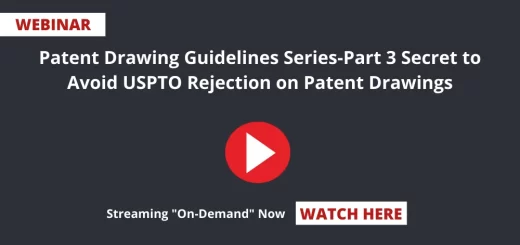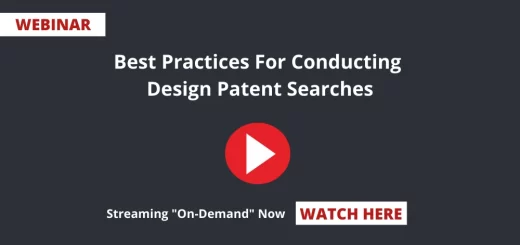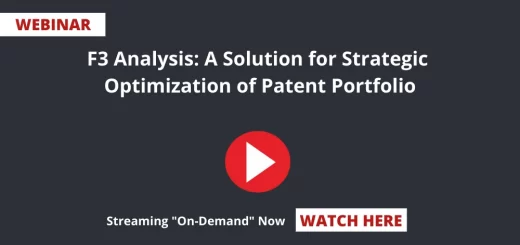Why Intellectual Property Strategy Is Important For Tech Unicorns – Webinar
Key-points Covered in this Webinar (Why Intellectual Property Strategy Is Important For Tech Unicorns) Session:
- Investigate the value creation dilemma – Intangible assets (IP) represent 84% of the value of the S&P 500
- Discuss how IP adds credibility to the overall value of the tech unicorns
- Address how to formulate holistic Intellectual Property Strategy for unicorns including Copyright, TM, Patents and Knowhow to build a sustainable and high-value ‘BRAND’
- Evaluate your current IP position and ways to expand the overall brand creation strategy.
Hosted By
- Mr. Umesh Amin (Board member and Advisor, Sagacious IP) – https://sagaciousresearch.com/our-people/umesh-amin/
- Mr. Anant Kataria (CEO, Sagacious IP)
- Mr. Jeffrey M Weinick (Guest Speaker from CSG law firm) – https://www.csglaw.com/biographies/jeffrey-weinick
Submit Your Information to watch the Webinar Video:
"*" indicates required fields
More Details about this Webinar:
In this webinar, we have invited thought leaders Mr. Umesh Amin and Mr. Jeffrey Weinick, who have addressed the ways in which you can ensure your enterprise value growth as you accelerate your journey as Tech unicorns.
Given the adaptability of Sagacious’ all-inclusive ecosystem for IP creation, it is now apparent that traditional asset based value creation will not suffice anymore. You as business leader, cannot afford risk of being persecuted (on IP fronts) as you build your company ground up. Instead, you must lay down a strong foundation for robust IP creation and capture policy to ensure sustained growth of the company as you reach your next milestone of going IPO.
Table of Contents
Webinar Transcript:
Introduction
Anant Kataria – Hello, everyone. I hope everyone is having a wonderful time. My name is Anant Kataria and I am host for this webinar today. I am CEO and co-founder of Sagacious IP and I’m glad that you chose to spend your valuable time with us today on this webinar and I’m very pleased to welcome you here.The topic of our webinar is Why Intellectual Property Strategy is a Crucial Part of Value Creation for Tech Unicorns and those aspiring to be tech unicorns.
To bring the perspectives and expertise of people who’ve driven such value creation successfully, we have seasoned experts from C suite advisory and from IP law firms, on this speaking panel today. I will now move on to introduce them. But before that, for those of you who may not know, Sagacious, I’ll just give you a quick summary.
Sagacious is an award winning IP and innovation consulting firm that has been enabling value creation in the innovation and IP ecosystem for the past 12 years with our 300 member team, from US, Canada, Europe, India, China, and Japan. Sagacious has had the opportunity to serve over 1500 clients, including IP law firms, Fortune 500 companies, startups, investors, universities, and other players in the innovation ecosystem from over 45 countries and over 16 languages and this also gave us the opportunity to work and partner with the speakers we have on the panel today.

Anant Kataria – So, without further wait, let me introduce our speakers of the day. Our first speaker is Mr. Umesh Amin. He has over three decades of experience, including in R&D at AT&T, where he helped build a strong portfolio of patents as an inventor and also leading the IP effort. Then he was also the chairman of Universal Wireless Communications Consortium. It’s an industry group that led IS 136, TDMA and IS 41 wireless technology.
He then became the VP of Wireless at Intellectual Ventures, IV and IV has been one of the most prominent IP holding and licensing organization in the US. And Umesh built a multi thousand patent portfolio and created a Successful licensing campaign licensing program, NIV. Thereafter, he has been an advisor to various startups, as well as to Sagacious, and is also a board member at Sagacious. Umesh welcome to the webinar.
Umesh Amin – Thank you, Anant.
Anant Kataria – Our next speaker, our second speaker is Mr. Jeff Weinick. Jeff is a USPTO Registered patent attorney. He’s a co-chair of Intellectual Property at Chiesa Shahinian and Giantomasi. It’s a law firm that has offices in New York and New Jersey. Jeff advises clients on patent law, trademark law, copyrights, and trade secrets and his practice includes prosecution, infringement, portfolio building, it’s the entire gamut on the IP site.
Jeff has also been in the IP space for over three decades, and has served clients ranging from Fortune 500 companies to technology startups. Before joining law firms he was patent attorney at AT&T, and then at Lucent Technologies, Jeff, welcome to the webinar.
Jeff Weinick – Thank you Anant, it’s my pleasure to be here.

Anant Kataria – Perfect, great. So let me now quickly lay down what we’ll cover in this webinar. We’ve broken this webinar down to four sections. The first section is where we’ll talk about, there’s a question a value creation dilemma that, what will add value to the startup that you’re involved in growing, right? We attempt to answer that question from an IP perspective. In the second section, we talk about how to holistically look at various IP based value creation opportunities you have.
In third section, we’ll talk about evaluating where you are in the IP awareness journey, and the fourth section, the last one, will focus on how you go about building your Intellectual Property Strategy and intellectual property for unicorns and building that value. And after these four sections, we’ll have a Q&A session. So I invite you to keep sharing your questions, as in when you have them. During the course of the session, you can share the questions via the question box on the right side of the presentation window, and I’ll pick up those questions in the end and take them with the speakers.
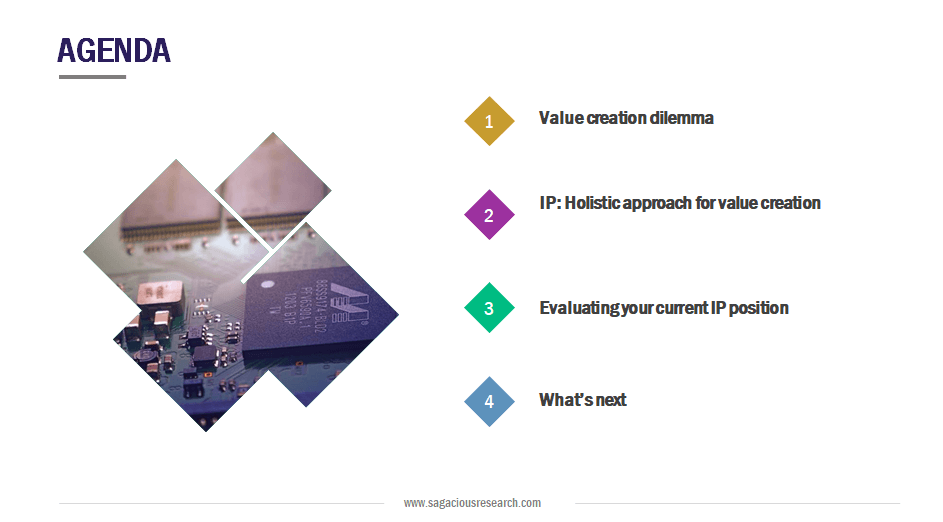
Let’s now get started with the main part of the presentation, and for that, let me invite Umesh to take up the first section about value creation. Umesh over to you.
Umesh Amin – Thank you, Anant
Value Creation

Good morning, good afternoon, good evening. We are delighted to have you all join us, on this important webinar, on Intellectual Property Strategy and Value Creation. From the attendee list that I’ve seen earlier, I can tell that some of the companies are valued in hundreds of millions of dollars. Some of your companies are valued in billions of dollars and all of are engaged in this very important equity building, part of your journey and many of you think that the valuation of your company is tied to some kind of or various financial matrices.
If you’re in the consumer space, you may think that your valuation is tied to millions of consumers who have repeat usage, the revenue, the profitability, and so on, and so forth. Or if you are in the enterprise services or product business, then you may think that your annual recurring revenue if you are in a service business, or in the general revenue, if you are in the product business to earn Fortune 500 customers, Fortune 50 customers, your global presence, the total Addressable Market, etc., may carry a significant weight in the value of your company.
Umesh Amin – As you continue this equity construction phase of your company, presumably, we’re going public or get acquired and some of you will become an S&P 500 companies.
How S&P Companies Are Valued Today
So let’s look at how S&P 500 companies are valued today. Next slide, please.
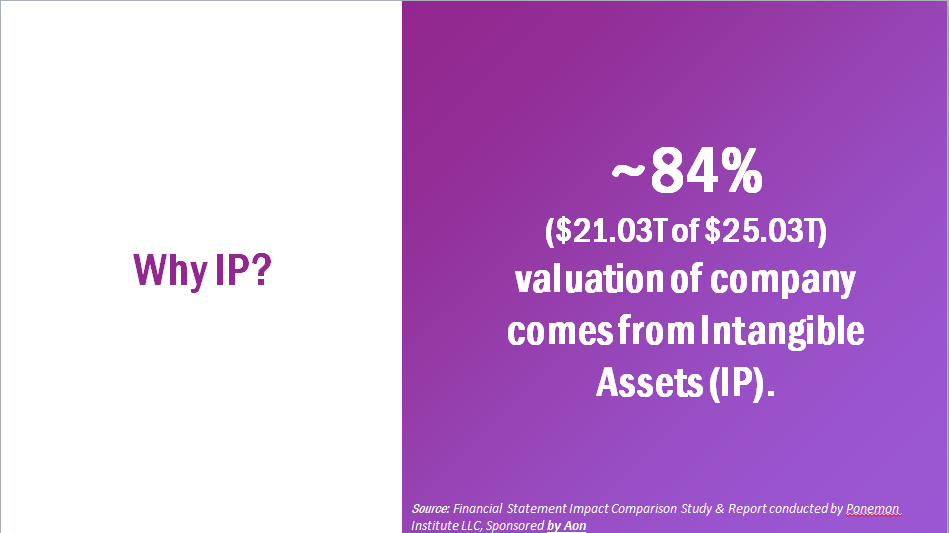
Why IP? If you look at in 2020, the S&P’’s 84% of the value for the S&P 500 is tied to intangible assets. Then those intangible properties are protected by intellectual property and legal rights. How did we get here? Let’s go to the next slide.

Umesh Amin – So, Anant as you saw in the previous slide, the S&P value is very strongly tied to the IP. When we look at historically about 45, 50 years back in 1975, tangible assets, like plans, factory’s, inventory products, those were the most important aspect of the overall valuations of companies, and S&P at large, and even the top five companies at the time were more focused on that kind of mix.
As we fast-forward decade over decade and come to 1990s, which was the beginning of the digital era or the digital economy with widespread use of computing and the birth of internet, we see that we became slowly and surely knowledge economy, and the valuation of companies, evolve from tangible property to intangible property. And as we move in the present time, we find ourselves in the context of overall value of company, overwhelmingly being supported by intangible holdings and IP.
If you look at the top five companies on S&P today, Apple, Google, Microsoft, Amazon, Facebook, all of them, over 90% or close to 90% of their value, is actually in that IP and intangible goods.
Umesh Amin – It should be noted that in, 2012, when Facebook went public in their S-1 filing, they had this sentence at the bottom that if we are unable to protect our intellectual property, the value of our brand and other intangible assets may be diminished and our business may be adversely affected. As you recall, in 2012, Facebook was the largest IPO in the history with $100 billion valuation. Next slide.
One of the core value of the overall intangible valuables is brand and there is a whole systematic approach that companies like yours need to have on how do you build that brand equity and how do you protect the brand equity? If you look at it, Amazon, their brand value alone is over $220 billion. Google 159 billion, Apple 140 billion, so on and so forth.
You may have or you may have your brand known to your sector, but there is a art to it on how you build the brand value so that the overall evaluation and the value formation journey is complete. Next slide, please.
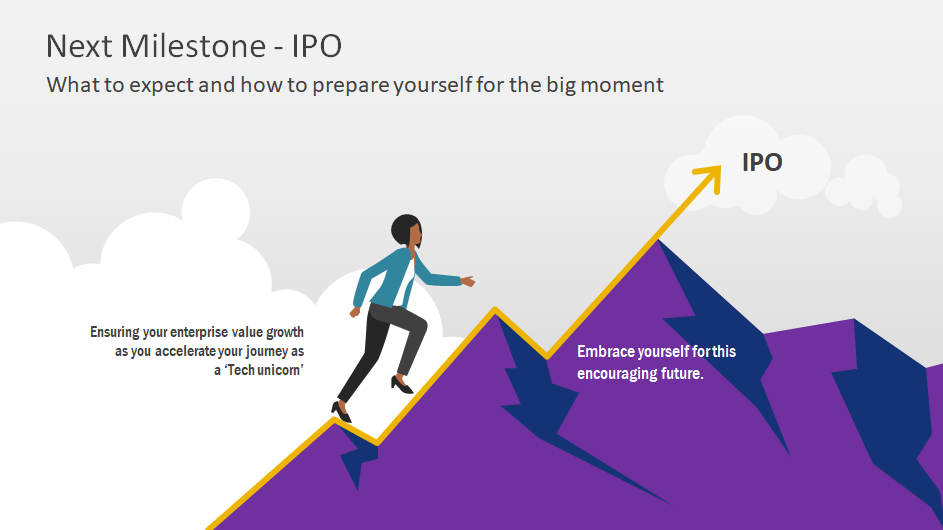
Umesh Amin – As I mentioned, all of you are in the value making journey. It is a natural next step for you to realize this value creation and equity raising journey with IPO for M&A. And that is the best way, to, reward your investors, and reward your equity, sweat equity players, who have help you build the company. Next slide, please.
The key here, in this knowledge economy, is as a unicorn, as you go to the next phase of IPO or public funding, you don’t want to lose your unicorn status because of the IP infringement or some other nobody says that you may receive. And this is not just the tale. Let me illustrate what it means.
Examples Of Intellectual Property Strategy For Unicorns
More than a decade ago, when Vonage went public and raised $500 million and, because of the IP dispute they ended a spending over $200 million of the 500 they had raised in settling the IP dispute. Facebook, as I mentioned earlier, in 2012, went public, and they received the notice from Yahoo, and they had to quickly act on it and subsequently act on it more, but ended up spending over $500 million because they did not have Intellectual Property Strategy for unicorns or IP innovation capture culture.
Umesh Amin – Twitter in 2014 when they went public. Just does this file that S-1.They were challenged by IBM and twitter ended up spending $36 million to acquire some assets to fortify type-e position. Groupon was an interesting case where they did not want to respect IP. They did not have IP capture culture. They went public very significant sum of money, IBM approached them. They refused to recognize Intellectual Property Strategy for unicorns . It ran into litigation in last year, I believe, last year or in 2018. There was a ruling in the court for 80 plus million dollars, and then they settled for 57 billion.
Last year, one of the highest flying star was Zoom. And even this year, it continued its journey, when they went public, because they did not have innovation capture culture, then also ended up getting into litigation and that litigation is still open. So all these companies on the top line above the line, are the companies that did not have innovation capture culture, did not have Intellectual Property Strategy for unicorns.
And at the most important time of the growth of the company tapping into the public market for additional funding, they ended up paying significant penalty for not having this Intellectual Property Strategy for unicorns in place.
Umesh Amin – On the other end, the companies at the bottom. Uber, Lyft, Dropbox, and Spotify each one in preparation for their IPO. They actually started the process one year, two year, three year earlier. For example, Uber hired, John Mulgrew, who put together the IP strategy and create the fortified position ,so that as they went public with fortify dollar share, an $8 billion raised. There did not face the same kind of obstacles that the other companies did and they did not end up spending bulk of the money raised in settling the ip dispute.
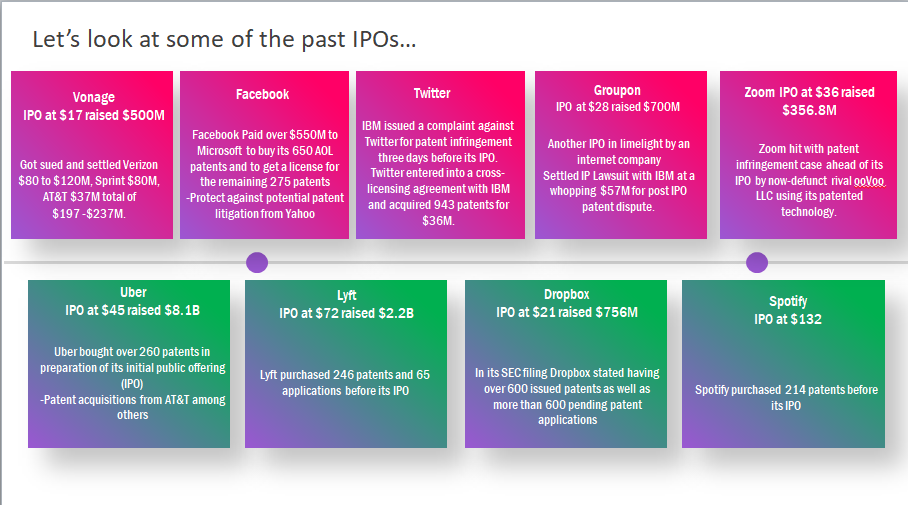
Lyft had also put together a team 18 months or two years before they went IPO and created a fortified position. Dropbox was more interesting, where in before IPO, they had bunch of merger and acquisition and through that, they were able to accumulate sufficient IP to protect themselves. And same thing, in terms of Spotify, which are the direct IPO, where they also acquired 214 assets before they ruined IPO.
It’s up to you in terms of how you think about your journey and how you want to reward yourself as you continue the journey to IPO. Next slide please. So far we have tried to establish the value of IP in the value formation. What exactly is IP? It means different things to different people. I want to invite at this point to my colleague, Jeff, to walk us through on what is IP and how it can contribute into value building?
Patents, Trademarks, Copyrights & Trade Secrets As Part Of Intellectual Property Strategy For Unicorns
Jeff Weinick – Thank you Umesh. So Umesh just spoke about the growing importance of intangible resources. What is the legal framework for creating these intangible belongings or as we call it, intellectual property? Next slide please. Generally when people talk about intellectual property where we’re talking generally about patents, trademarks, and copyrights but also know-how or trade secrets also fall within the framework of legal protection for intellectual property. I’ll go into more detail in each of these a little bit later, but for now, just an overview.
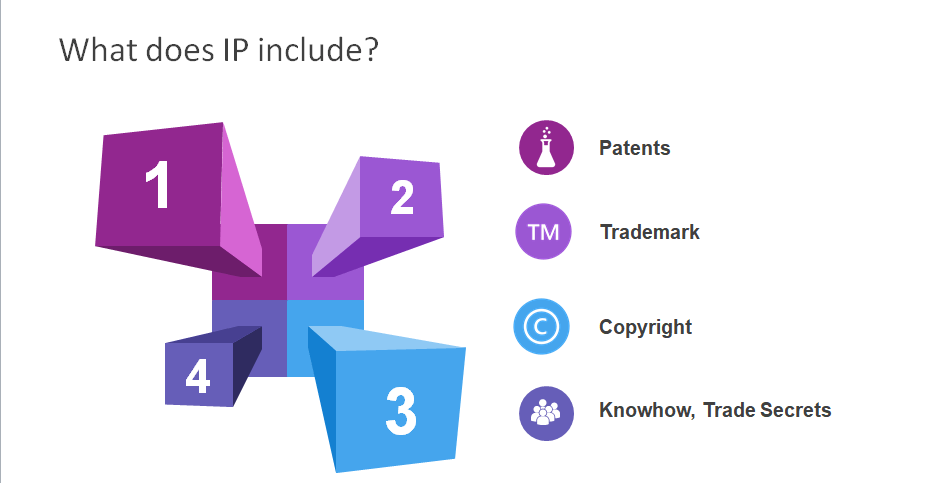
What is a patent? A patent protects the idea of a product. Often, when I’m describing this framework, I like to give an example. So, consider Microsoft Excel Spreadsheet. If I’m the first to invent that spreadsheet, a patent would protect the idea of the spreadsheet of Sheets with cells, cell relationships with each other, automatic updating of cells, when other cells are changed. Basically the functionality of what a spreadsheet is or does.
Trademark, on the other hand, identifies the source of a product. For example, the name Excel. That’s the trademark for the spreadsheet. And that identifies the source, it’s coming from Microsoft. It doesn’t protect the product itself, only the identification of the source of that product. Copyright would protect the expression of an idea. For our spreadsheet example, that would protect the computer program code itself, not the functionality of the code, but the actual code, and it’s protected from copying.
Jeff Weinick – So at least in the US, independent development is not copyright infringement, even if it’s very close or even exact copyrights, only protect copying of some expression of an idea. And finally, trade secrets would protect confidential information that’s secret and not public. Perhaps there are some efficiency algorithms within the spreadsheet that have not been patented and have not been disclosed, and those could be protected with trade secrets. If we can go onto the next slide, we can talk a little bit more about patents.
Patents & Types Of Patents
Patents really are the foundation of protection for innovation companies. These protect the ideas and the important products and services that a company is going to provide and protects against competitors copying those ideas. The bargain that you get with a patent is that the government makes it deal with you. You have to fully disclose your invention, and add it to the public knowledge.
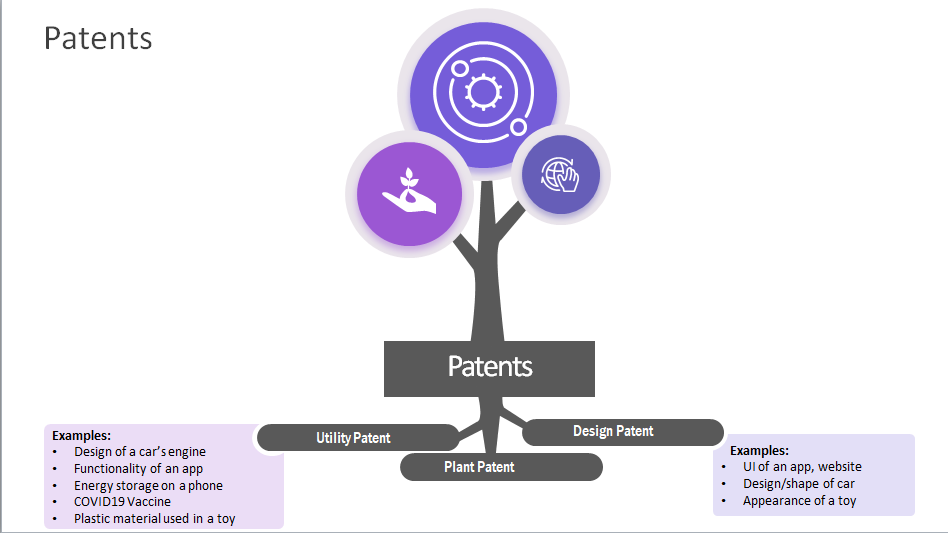
And, in return for that, depending on the jurisdiction, you’re in 15 or 20 years of exclusive rights to that invention. Now, one thing that’s important about patents that people don’t always recognize is that a patent is the right to exclude. A patent is not the right to do anything. Just having a patent doesn’t give you the right to do something. It gives you the right to exclude others from doing it.
Jeff Weinick – So, it is possible that you could have a patent on a product improvement not be able to practice it or sell it, because the product itself or a broader patent is in existence. It’s somewhat beyond the scope of this presentation, but that that is a possibility.
As you can see by the slide, there’s three types of patents, and, again, I’m talking about this from a US point of view, but most countries have similar concept to these types of patents. Although, sometimes with different names. So, a utility patent is what most people think about when they hear a patent, protects the product itself or the technology or the idea. For example, car’s engine, how it works, how it’s designed the functionality of an app, or storing energy storage on a phone, Vaccines, things like that are what are protected by utility patents.
Design patents, on the other hand, protect the ornamental design of an article of manufacture and these design elements are have to be non functional. Design patents are not intended to cover any functional elements of a design only the ornamental design. For example, design patents have been used to protect user interfaces, website design, the shape of a car, or the appearance of a toy things like that that are non functional, but somehow are ornamental designs.
Jeff Weinick – And finally, plant patents, which cover new plant varieties, are also very specific and not really within the scope of this discussion.
Patents are geographically limited. So it has to be understood that a patent in one country only protects within that country within the boundary it could protect, from making, using, selling, importing, but it doesn’t give any protection outside that country. And because patents are the broadest type of protection, they are also the most difficult to obtain and the most expensive to obtain. But it could take years and tens of thousands of dollars in order to obtain a patent.
But, again, in return, you’re getting a 15 or a 20 year monopoly. The requirements of patents are generally the same in many different countries that the invention has to be useful. It has to be eligible for patenting usually related to some technology, it has to be new. Sometimes that’s called novelty. But beyond novelty, it also has to be not obvious.
Jeff Weinick – So, even if it’s not, even if it’s new, it could be obvious if there are things you could combine in the public domain to come up with it. A patent also has to be non obvious to be issued. Okay, if we go on to the next slide we can talk about trademarks.
Trademarks

As I mentioned before trademarks protect the identification of source, where is the product coming from? It’s really a recognition of a goodwill of a company and it helps consumers make decisions. For example, if you’re traveling away from home and you see a restaurant brand that you recognize them that you like, you might be more likely to eat there because the trademark tells you something about the quality of the food, the source, it’s not just some some random product.
Terms of trademarks vary a bit from country to country, but one thing that is consistent is that they are renewable. There’s no time limit or a termination on a trademark. As long as it’s being used they’re able to be renewed. It’s always a good idea to do a search in order to evaluate the possible possibility of you using or someone else perhaps using a name that you’ve come up with prior to investing a lot.
Jeff Weinick – So before you come up with packaging or service marks or advertising or marketing material, you should do a search on the trademark name, make sure that the trademark is available for use. It’s especially valuable, for new products and new releases.
Registration of a patent is not strictly required. There are common law rights, but there are benefits to registration. For example, at least in the US, Federal registrational provide notice to the public of a claim to ownership. It gives a legal presumption of ownership and it provides for exclusive rights in connection with certain goods and services.
Copyrights As Part Of Intellectual Property Strategy For Unicorns

Okay and now you can move on to copyright. If you remember, as I talked about earlier, copyrights protect the expression an idea, but not the idea itself. It doesn’t protect against independent design or reverse engineering. Right, so, if someone looks at the Excel example, right? Someone looks at an Excel spreadsheet, understands the functionality, and they recreate that in every way.
Jeff Weinick – As long as they’re not actually copying this the source code for Excel, there’d be no copyright violation. Copyrights are of limited importance, I think too many, tech companies, probably less valuable than patents, and there are more useful and artistic areas, such as literature, music, photography, where the value often is in the expression, not in the idea. For example, if a painter paints a beautiful sunset, the value of that painting is in the paint series expression.
We’re not looking to stop other people from painting their own sunsets, but it’s that that expression, that’s valuable. Copyrights also vest upon creation. So as soon as an author puts pen to paper, or an artist puts brush to Canvas, copyright exists and invest in that work of authorship. No registration is required. Although there are some benefits to registration in many countries, if you go on to force that trademark, I’m sorry, the copyright. Okay, now, if we can move on to the next, and final prong of the IP is the Trade Secrets.
Trade Secrets: The Final Prong of Intellectual Property Strategy For Unicorns

Trade secrets protect, valuable, confidential information that’s kept secret, and there’s really three important factors to a trade Secret. It has to be information. It has to be secret, and, secrecy, and it has to have some inherent value. It has to be valuable. Those three things are, the, are the linchpins to a trade secret. All trade secrets are confidential information, but not all confidential information rises to the level of a trade secret.
Jeff Weinick – For example, my firm has a commercial agreement where with a cleaning crew that comes in every day and cleans the office, it’s an important contract for us. The terms are confidential, so the terms and the existence of that contract, we have are confidential, but it’s not a trade secret. There’s no inherent value in that information to my company.
On the other extreme, and probably the best known example of a trade secret, is the formula for coke, right? That is probably one of the most valuable trade secrets in the world. And its value is in its secrecy.
So often when a client comes to me with an invention, the patent versus trade secret balance is an important consideration and a conversation that we often have because there’s important differences, right? Timing, so patents have no patents have a limited term of 15 or 20 years, but trade secrets have no expiration. As long as you keep it secret and it has value, it doesn’t expire. If we look at Coke, imagine what would have happened if they patented that formula.
Jeff Weinick – Let’s just assume it could be patented. If coke had patented their formula, it would have expired many, many years ago, and it would be in the public domain now. And anyone could produce the same formula. But because they held it in secret, it’s still very valuable intangible asset to the company. Patents require disclosure. That’s the bargain you make with the government. I’m going to disclose this to the public and I’m going to get some exclusive rights.
Trade secrets on the other hand, prohibit disclosure completely. Once it’s disclosed, it’s no longer protected. Reverse engineering and independent Invention Patents will protect if someone independently invents or reverse engineers your invention. Trade secret will not protect that. If I can go into my kitchen and come up with the formula for coke, I have every right to go out and sell it.
I did not misappropriate anything, I reversed engineered it and that trade secret is now gone. Consider how long will something be valuable, right? Technology moves so fast that if it’s going to be valuable and only the first five years, it might be better off keeping a trade secret because it could take 2 to 4 years to even obtain a patent. And of course, I know the cost patents are expensive.
Jeff Weinick – Trade secrets, some people think they’re free, but I don’t think so, there is an inherent cost to any company to track trade secrets and to appropriately protect them and keep them Secret. Next slide.
Okay, those are the, we just talked about the four prongs, generally at a high level of intellectual property, and how different ones of those prongs can be used to protect different parts of a company’s technology brands confidential information. Where are you in this journey of protecting your IP? You’re to go to the next slide.
Intellectual Property Strategy For Unicorns Stages

It’s important to evaluate where are you on this chart, right? Or you just? In Stage one, right, you’re just germinating, your IP journey. You know IP is there. You know there’s something called IP and there’s patents, trademarks, but you don’t really have a Intellectual Property Strategy for unicorns yet. But maybe you’re just starting to think about how to how to get started. Or are you in this middle ground of growth, where, you have a good idea of the relevance.
Jeff Weinick – You’ve identified some IP already, you’re managing it, somewhat ad hocly, but you’re managing it, you do have some process for capturing the IP. Or are you at number three, where ultimately, you probably want to be, is that you have a strong policy in place. You have IP policies, IP procedures, you can track your IP, your benchmarking the value of it.
So a company could be in any one of these, these three stages of awareness, but it’s important to think about where you actually are in this process. Next slide. What’s the next step? And this is where I will pass it off back to Umesh, and he will continue to talk about what are the next steps?
Umesh Amin– Thank you, Jeff.
For each of your phones, in your IP awareness journey, as Jeff pointed out, you could be at different phases. And, quite frankly, regardless of which phase you are in even if you are in the Phase three, where you have Intellectual Property Strategy for unicorns and everything in place, I would like you to, at least reevaluate. Is your Intellectual Property Strategy complete? Is your Intellectual Property strategy for unicorns effective?
Then obviously if you are at the Ad hoc phase or the germination phase then it is very vital to put together an IP strategy because Intellectual Property Strategy for unicorns is a core element or vital element of your value creation journey. Here are some of the steps that I have outlined.
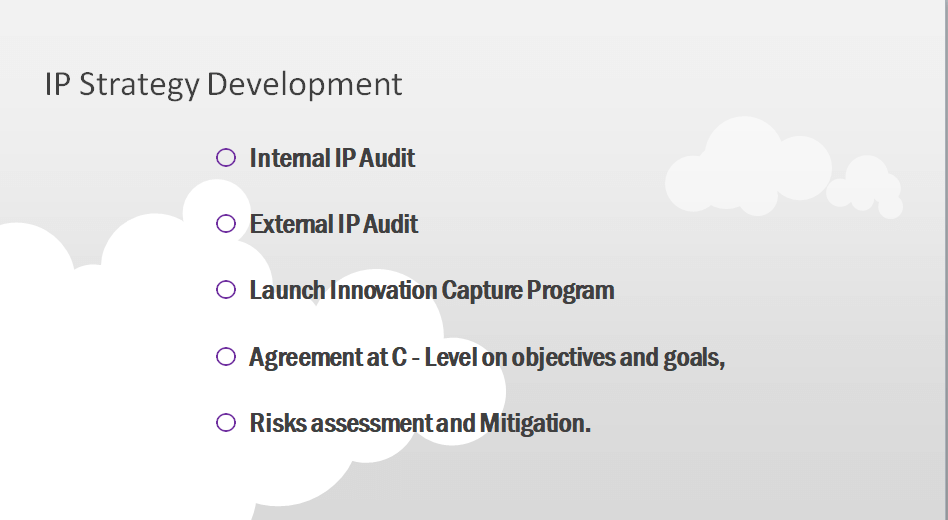
Umesh Amin – Presumably, we’ll have a follow-up webinar on Intellectual Property Strategy development, and more details, we’ll have the opportunity to share with you a lot more details. Now, as we establish so far in this webinar, we are in the knowledge economy. And IP is very valuable, IPs generated by all your employees, and own aspect of your operation. It’s very important to have internal audit to understand all these IP generator, who owns it?
Do you have as a company, or c level in the company? The rights establish so that these IPs captured and can be harnessed for the valuation. You have partners, because now, in this knowledge economy, the value system is very different than the vertically integrated operation the way Henry Ford had back in his days. We have a very strong intertwined relationships with partners, consultants, contractors, and all these external players same way having a right system in place.
First, doing the party and putting the right system in place is very important so that this IP that’s created internal and external, is harnessed for the value creation. If you have innovation capture program, wonderful, if you don’t have one putting together the right context, depending on your near term and long term strategic goals.
Umesh Amin – Putting an innovation capture program is very important, and there are elements of innovation capture program, which putting the right way so that it actually is very effective in the long term success of the company. This is not a one-off initiative that you can run as a designated person, doing something, and the rest of the people being in the audience.
This is an exercise that requires a C level of commitment, an agreement, and potentially setting up innovation, capture, or the IP governance council, so that not only you have put together the plan, but you also are measuring and tracking the plan against the set objectives and goals. And as you continue this journey, assessing the risk is very important and how to assess and mitigate risk plays a significant role in the overall strategy. Next slide, please.

As you develop the Intellectual Property Strategy for unicorns and start implementing it, it has invariably three phases. You launched the Intellectual Property Strategy for unicorns, part of the innovation capture culture within your company within your organization. That is a lot of heavy lifting there has to be done so that you can truly establish this cultural aspect of value creation through Intellectual Property Strategy for unicorns . And, this innovation capture culture is a very, very serious effort required, measured approach that has to be instituted.
Umesh Amin – Now, many of the startup sort of small companies or even unicorns get too caught up in their operations and success in the market. But, if you don’t have right culture, your success will be limited. And same way in your value system, for the pillars of your culture, innovation capture has to be one of them in order for you to be successful in the IP capture and the IP value creation. Part of the, some other elements in there are also setting up the right processes and then persistent reinforcement, so that this culture becomes pervasive.
Some people may have questions about what do I mean by culture? I’m of Indian origin, I’m vegetarian for generations. That’s part of integral part of who I am or what my culture is, so, no matter how hungry I am. And if I see Food, the first thing that comes to my mind is, is this vegetarian food for me to consume? And if it’s not, I would walk away.
Same way IP is created all over the company, and innovation capture culture is awareness among all the people involved in the IP creation, or monitoring, or capture are always thinking about, is this something important for us to capture? Is this something important to your evaluation journey? That second, that thought process, is integral part of culture, and they act on it is also important part of culture.
Umesh Amin – Once you launch this program carefully, and then start focusing on key measurable matrices so that this is really happening.
Risk Assessment As Part Of Intellectual Property Strategy
The next part is doing the risk assessment, and figuring out, what are the Key things that needs to be worried about? We talk about on the patent risks. For example, in my earlier part of the presentation, where companies going public not having the Intellectual Property Strategy or innovation capture Culture ended up being significant penalty. But that are ways and means for doing the systematic analysis to identify the risk, assess the risk, and mitigate the risk.
You have launched new product line, but your product line has certain name. But when you launch that product line, if you haven’t checked for the trademark or the ownership right, for that particular term that you are using, then you are disrupting, and then somebody else has that as a trademark registered trademark, then all of a sudden, your brand equity building is going to be interrupted.
Umesh Amin – You’re going to have to rework the name of the product, and then start rebuilding or realign your brand value creation.
Same way on patent front. If you had not captured your ideas for patenting, then it becomes and then you launch the product then your ideas and concepts become community property, and it creates risk for your existing business. So there are scientific and legal ways of establishing risk assessment and mitigation criterions and work arounds. Those are important part of this Intellectual Property Strategy.
In the development phase, as the innovation capture is going very well, want you to focus on that part. And then, as you fast forward, and you actually have created a very strong portfolio of IP, either to risk mitigation and ip acquisition, or to yard internally grooming the IP and capturing it and then all these value creation is created. That is the point when you can harvest the value of your IP.
Umesh Amin – As Jeff talked about earlier, the patents are negative rights, it’s the right to exclude. If you are very successful with your product line, in your market and 10 other competitors are trying to copy or imitate you. This is where you can harvest the IP rights that you have developed in the IP assets that you have developed to continue your journey with sustained growth and competitive advantage.
So far we appreciate the time in this webinar, and we have clearly demonstrated the Intellectual Property Strategy is an integral part of the overall value creation journey for tech unicorns. Next slide.
I would like to turn it over to the moderator for question and answer at this point.
Q&A And Conclusion
Anant Kataria – Great thanks, Umesh. Thanks, Jeff. I think you covered all the points pretty nicely. We do have some questions from the audience that I would like to take but before that, I would just like to highlight that when we were preparing for this webinar, we realized that the topic of IP based value creation is too big to be covered in just one webinar. We’ve tried to create a series of webinars in the first one, which we, are just about to complete after the question and answer session.
We broadly covered about why Intellectual Property Strategy is crucial for value creation. And in the next ones will be actually focusing on the launch, develop, and harvest stages that you see here. And in those webinars, we’ll share the best practices and strategies for each of these tips. You will receive e-mails from us about the dates of these webinars, and I request you to register and join us for those webinars as well.

Now, I’ll move to the questions up, but before that, as in the initial stages, some of the slides got skipped in terms of being presented. I’ll take the screen, to the audience slide, the speakers’ slides so that when we, when they answer the questions, who’s answering and probably, briefly, introduce the speakers again, so that when I introduced them earlier, you may not have been able to relate them to the faces and know what’s written about them, so quickly.
Anant Kataria – Umesh, he comes with three decades of experience in R&D at AT&T where he built a strong portfolio of patents and also lead the IP activity there. Then he was also the Chairman of UWCC. It’s an industry group that led the IAS 136, TDMA, and IAS 41, wireless technology adoption. He was also the VP of Wireless at Intellectual Ventures where he built a portfolio of several thousand patents and created a strong licensing program for them and then he has been advisor to various startups of all sizes and is also a board member and advisor to SAGACIOUS.
Jeff is a USPTO registered patent attorney. He is the co-chair of Intellectual Property Group at CSG. With offices in New York and New Jersey, he advises his clients on patent trademark, copyright trade secrets. All the points that he shared when he was talking about the holistic approach and his clients have ranged from Fortune 500 companies to technology startups. And before getting into law firm, he was in house as an IP attorney, actually building the IP portfolio for companies like AT&T and Lucent.
I’ll stay on this slide and then I’ll move on to the questions that I have .
Anant Kataria – First question, that’s, I think it’s for Jeff, Jeff, the question is, I’ll just read it verbatim. We’ve heard software is not protectable by patents. How can a product protect my startup that’s primarily a mobile app?
Jeff Weinick – Yeah, right. We often hear that software is not protectable, but really, any software itself standing alone is cannot be the subject of a patent, but software implemented inventions are subject matter that can be protected with patents. It’s become somewhat more difficult over the last eight or so years, especially in the US to protect these inventions because they are often categorized as so-called abstract ideas.
The more mathematical they are of pure math or what’s known as mental steps, if it could be done in the human mind or, if it’s really based on commercial transactions between parties, those things are very difficult. But if a company has a technological invention that is based software or implemented in software, those certainly still can be patented.
Anant Kataria – Okay and the next question is, What’s the best way to protect the user interface of an app? Umesh would you be kind to answer this one?
Umesh Amin – Sure. So, yeah, in this digital economy, software driven products and services are in place. And what happens inside the program is not as relevant as how the users interact with the product. Intellectual property created from the user design ,user interface design is very important to protect, and the best way to protect that, is having the design patents. You can see the three types of patents that Jeff talked about.
The design patents is crucial for UX design protection. And the best example of protecting their design is the best design company, I know of which is Apple. And how they have got hundreds of thousands of patents, including design patents, to protect their user interface design as well as some of the touchable design.
Anant Kataria – Okay, up maybe up a quick extension of that question, maybe for Jeff, this is just from me Jeff. What role would have copyright protection play in terms of user interface? Do you think it’s, it’s also beneficial to have that, what are your views there?
Jeff Weinick – Copyright, could protect the user, a user interface. Particularly if there are any artistic elements to that interface, the copying of those would be copyright infringement. Also, the layout and design, it would have to be a direct copy for there to be copyright infringement. But certainly copyright could protect the most egregious of misappropriation in that respect but it won’t protect independent development of similar interfaces.
Anant Kataria – Okay, next question again, I’d say if you could continue in that, when it’s about trade secrets. It’s about how to protect trade secrets and what are the reasonable steps?
Jeff Weinick – Yes, there’s no real bright line rule for what is reasonable to protect a trade secret. It will depend on the particular circumstances of the company and the nature of the trade secret. There are some steps that are that are probably universally important are limiting disclosure. Both inside the company and outside the company.
So within the company, you only want to disclose to employees that actually have a need to know. If you are disclosing outside the company, for example, to vendors or to others who you need to disclose it to, it should be under a non disclosure agreement. But I often caution clients regarding the effectiveness of non disclosure pacts. It’s much more important, to have trust in the person you are disclosing to.
Because if you disclose a trade secret to somebody, even under an NDA and that person misappropriates or discloses if the trade secret is lost and the only recourse the company would have would be to go after the person who had disclosed it for damages and very often those damages the person who disclosed it cannot pay damages sufficient in order to compensate the company.
Jeff Weinick – I mean, for example, right, we use the Coca Cola example, for some reason, they decided to disclose their formula to me, under a non Disclosure deal. I went ahead and disclose, and then printed that recipe in the New York Times, so to say, right. Their, the trade secret is gone. Anyone could use that, and they’ve just coke has lost their trade secret, they can try to sue me for the value of that trade secret, but they’re not gonna, they’re not gonna get anywhere near the value of it for me.
NDA should be used, but I always caution regarding how strong they are.
Back to the reasonable steps, protect the physical access to any trade secrets locked Cabinets, educate, and train your employees. What is the trade secret? What does the company expect of its employees? Have passwords on all systems, electronic passwords for computer systems, physical access points where people can’t get past if they don’t need to, or things like that are all things that will be taken into account if a court ever has to decide whether someone took reasonable steps to protect the trade secret.
Anant Kataria – Got it. This is quite interesting, Jeff. And I think, when we do the next webinars, we’ll probably cover some of these aspects in more detail. But I think this sounded enough.
Jeff Weinick – We can certainly spend an hour seminar on trade secrets alone.
Anant Kataria – Right
Anant Kataria – Next question we have, I think, Umesh, this is directed to you. This is corresponding to one of his slides. It says, you mentioned about internal audit. If we do not have any IP, do we still need an internal audit, and what would that include?
Umesh Amin – Okay, I think any company in today’s time think that they don’t have IP is really misleading themself or are in disbelief, because in a knowledge economy IP is generated by all employees and processes, and their go to market and everything. It’s just a matter of recognizing what is IP. What is valuable so that they can protect it. Internal audit is very important.
In terms of even simple thing, like our employee contracts written right ,employment contracts are properly executed so that any IP created by employees belongs to the company. Internal audit will bring out all the shortcomings that may have happened because a startup, when they start building, when, they start the company, IP is never in the forefront of the thought process, it’s the idea as raising fonts, putting operations together, going to market, all these other things take precedence. Somewhere along, when you start focusing on IP, it’s very important to actually understand who owns those rights and IP audit would provide clarity about it.
Anant Kataria – Okay, perfect, thanks Umesh. I think we have just one more minute left, so we have some questions, but, we, I think we may not be able to take them, I think it was great, it has been a wonderful session, I’m sure the listener’s they have been able to have some takeaways from this session and probably will be able to use some of these pointers when they work on their Intellectual Property Strategy in businesses.
I still invite everyone to wait for the e-mails you receive from us, for the next webinars, and please do register and join, some of the aspects of the strategy, the three stages, would be covered in more detail in the subsequent Webinars and thank you, Jeff, and Umesh.
Thank you so much, and thank you to the listeners as well who helped to start on time and finish on time. I would look forward to seeing you in the next webinars and have a great day. Thanks Umesh, thanks Jeff.
Jeff Weinick – Thank you.
Umesh Amin – Thank you.
Submit Your Information to watch the Webinar Video:
"*" indicates required fields

